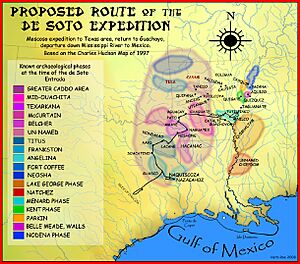Tula people facts for kids
The Tula were a group of Native American people. They lived in the area that is now western Arkansas. We only know about the Tula from the writings of a Spanish explorer named Hernando de Soto. He traveled through North America a long time ago.
Contents
The Tula People's Story
The Tula might have been part of the Caddoan people. However, historians are not completely sure about this.
Where the Tula Lived
The Tula's homeland was likely near the start of several rivers in Arkansas. These rivers include the Ouachita, Caddo, Little Missouri, Saline, and Cossatot Rivers. They may also have lived in the northern Ouachita Mountains. This area includes the Petit Jean and Fourche valleys.
Encounters with De Soto
Hernando de Soto and his group entered the Tula lands on September 30, 1541. This was near where Fort Smith, Arkansas is today. De Soto's group had many battles with the Tula tribe in early October 1541. Rodrigo Ranjel, who worked for de Soto, wrote about the Tula. He said they were "the best fighting people that the Christians met with."
A statue was put up later to remember the Tula people. But experts on de Soto think the statue is not in the exact place where the Tula lived. The Tula are believed to be the first Caddo group to meet Europeans.
Tula Customs and Warriors
Spanish writers from the 1500s described some interesting Tula customs. The Tula practiced cranial deformation. This means they shaped the heads of babies. They also tattooed their faces. The Tula warriors fought using large spears.
Tula Village Sites
Archaeologists have found a site called Bluffton Mound Site (3YE15). It is about 35 to 40 miles southwest of the Arkansas River. This site is linked to the Tula people. It is a Caddoan Mississippian culture mound center. This means it has large, flat-topped mounds built by the Caddoan people.
The Tula Today
A historian named John Swanton suggested that the Tula joined other Caddo tribes. This means that their descendants might be part of the Caddo Nation of Oklahoma today.
What "Tula" Means
The word "Tula" is not a Caddo word. The tribe and their land are also sometimes called Tulia.


